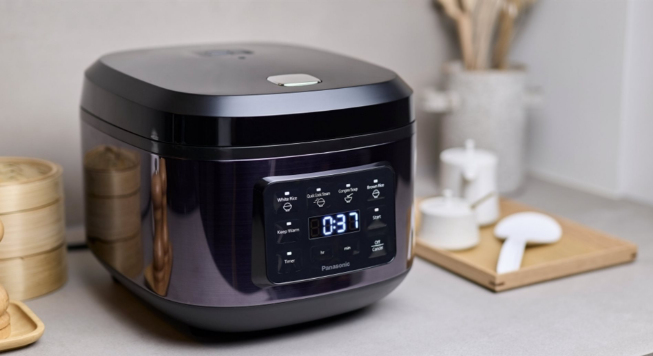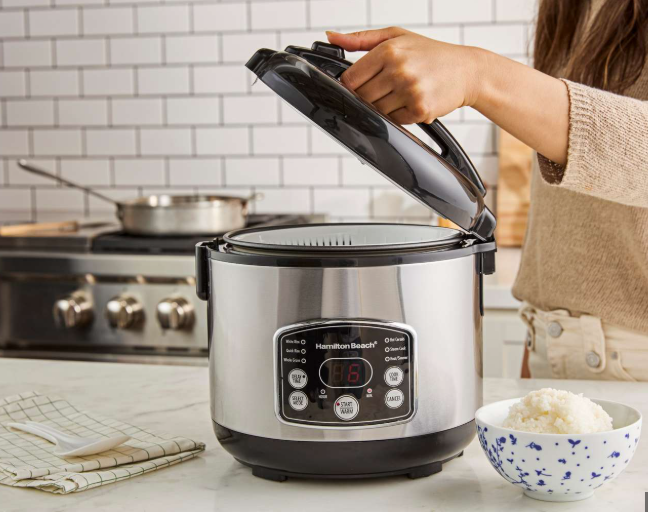Welcome to our comprehensive Panasonic electric cooker review, your ultimate guide to unlocking the full potential of this versatile kitchen appliance in 2025. Panasonic electric cookers, known as rice cookers or multi-cookers, are celebrated for their precision, durability, and beginner-friendly features, making them a top choice for students, professionals, and families. These devices simplify cooking with electric cooker by effortlessly preparing rice, soups, steamed vegetables, and more, saving time and energy. Compact and travel-friendly, they’re perfect as a portable electric cooker for small spaces or on-the-go meals. This electric cooker user guide walks you through every step to master your Panasonic cooker. For more tips, explore our electric cooking tips.
In this Panasonic electric cooker review, we cover preparation, a step-by-step cooking guide including how to cook rice in an electric cooker, maintenance advice, troubleshooting solutions, and answers to common questions. Whether you’re using a basic model like the Panasonic SR-3NA or a high-tech IH cooker, this guide ensures success. Always consult your model’s manual for specific details. Let’s dive into this Panasonic electric cooker review and make cooking in 2025 a breeze!
What You Need Before Using
Before exploring this Panasonic electric cooker review, proper preparation is key to a seamless cooking experience. Your Panasonic electric cooker typically includes a main unit, a non-stick inner pot, lid, measuring cup, and spatula. Advanced models, like the SR-CN188, may include a steaming basket for versatile cooking. If any accessories are missing, purchase Panasonic-compatible replacements to ensure safety and performance.
Check your cooker’s power compatibility—Panasonic models typically operate on 120V or 220V outlets, depending on your region. Verify the capacity: 3-5 cups for individuals or small households, 8-10 cups for larger families. Choosing the right size prevents spills or uneven cooking. For example, overloading a small cooker can cause messy overflows, so align capacity with your needs.
For electric cooker safety, place the appliance on a stable, heat-resistant surface, away from water to avoid electrical hazards. Inspect the power cord for damage—replace if frayed. Use in a well-ventilated area to manage steam buildup, and never leave it unattended while operating. For portable electric cooker models, ensure stability during transport to prevent accidents.

Before first use, clean the inner pot, lid, and accessories with warm soapy water, rinse thoroughly, and dry to remove manufacturing residues. Use the provided measuring cup for accurate portions—a 1:1.5 rice-to-water ratio is standard for white rice, with adjustments for brown or sticky varieties. Read the user manual for model-specific details, such as button functions or smart features like fuzzy logic technology. For electric cooker maintenance, clean after each use to prevent buildup and extend lifespan.
Gather ingredients like rice, vegetables, or broth in advance. Keep children and pets away from hot surfaces, and use oven mitts when handling the pot. Use a dedicated outlet to avoid circuit overloads, and consider a surge protector in areas with unstable power. These steps ensure a smooth electric cooker setup. For more setup advice, visit our cooker guide.
Step-by-Step Cooking Guide
This Panasonic electric cooker review offers a beginner-friendly electric cooker user guide to help you cook with confidence. We’ll cover preparing ingredients, electric cooker setup, selecting modes, starting the cooking process, testing doneness, and electric cooker troubleshooting.
Preparing Ingredients
Start by preparing your ingredients for consistent results. For how to cook rice in an electric cooker, rinse 1-2 cups of rice under cold water until clear to remove excess starch, ensuring fluffy, non-sticky grains. Drain thoroughly. For soups, chop vegetables like onions, carrots, or celery, and measure broth or water. Season with salt, herbs, or spices early to enhance flavor. For steaming, place vegetables, fish, or dumplings in the steamer basket. Preparation takes 5-10 minutes but ensures high-quality results when cooking with electric cooker.
Setting Up the Cooker
Plug your Panasonic electric cooker into a stable outlet on a flat, heat-resistant surface. Insert the clean inner pot, add your prepared ingredients (e.g., rinsed rice and water), and secure the lid until it locks with a click. Select the cooking mode using the intuitive control panel—Panasonic models often feature clear buttons or digital displays for ease.

For portable electric cooker users, ensure the unit is stable, especially when traveling. Check the lid seal to prevent steam leaks, which can disrupt cooking performance and efficiency.
Selecting Modes
Choose the appropriate mode for your dish. For rice, select “White Rice,” “Brown Rice,” or “Quick Cook” for optimized timing—Panasonic’s advanced fuzzy logic technology ensures perfect texture. Use “Steam” mode for vegetables or fish, adding 1-2 cups of water below the basket. “Soup” or “Porridge” modes are ideal for slow-simmered dishes like stews or oatmeal. If your model lacks presets, set manual times: 20-30 minutes for rice, 45-60 for soups. Start with simple modes to build confidence in cooking with electric cooker.
Starting Cooking
Press “Start”—the indicator light or display confirms operation. Panasonic cookers feature precise temperature control, so steam vents release pressure safely; keep them clear to avoid buildup. Avoid opening the lid during cooking to maintain consistent heat. The cooker automatically switches to “Keep Warm” mode when done, maintaining food at serving temperature without overcooking. Cooking times vary by dish—smaller batches cook faster, typically 15-20 minutes for rice.
Testing Doneness
After switching to “Keep Warm,” wait 5-10 minutes for settling to allow flavors to meld. Open the lid carefully with oven mitts to avoid steam burns. For rice, fluff with the provided spatula and check for tenderness—grains should be soft but not mushy. For soups, taste for seasoning and texture; vegetables should be tender. If undercooked, add a small amount of water and restart for a short cycle. For steamed items, pierce with a fork—they should be tender yet crisp. Panasonic’s even heat distribution minimizes undercooking issues.
Troubleshooting
For electric cooker troubleshooting, address common issues with your Panasonic cooker. If it doesn’t start, verify the plug, outlet, and lid seal—Panasonic models require a secure lock to operate. Burnt food? Increase water or clean the pot thoroughly, as residue can cause sticking. Overflow? Reduce ingredient quantities to stay within capacity. Uneven cooking? Stir midway if the recipe allows. For error codes (e.g., E01), consult the manual—often related to sensors or overheating. Clean clogged steam vents to restore function. If problems persist, unplug, let cool, and retry. This Panasonic electric cooker review covers most scenarios, but your manual is essential for specific fixes.
With practice, you’ll master electric cooker recipes like quinoa porridge, steamed dumplings, vegetable soup, or even cakes in compatible Panasonic models. Start with simple dishes to build confidence and explore creative recipes.
Tips for Successful Cooking
Maximize your Panasonic cooker’s potential with these best electric cooker tips from our Panasonic electric cooker review. For electric cooker maintenance, clean the cooled inner pot with a soft sponge—avoid abrasive scrubbers to preserve the non-stick coating. Remove detachable parts like the lid or steam tray, wash with warm soapy water, and air dry to prevent mold. Never immerse the base in water; wipe it with a damp cloth.
For electric cooker safety, use wooden or plastic utensils to protect the non-stick surface from scratches. Store in a dry, cool place to avoid damage. Save energy by cooking in batches and leveraging the “Keep Warm” mode’s residual heat—Panasonic cookers excel at energy efficiency. Choose insulated models for better performance and lower power consumption.
Explore electric cooker recipes beyond rice, such as oatmeal, steamed eggs, yogurt, or desserts like custards in compatible models. Add seasonings post-cook for flavor variety. For portable electric cooker use, pack securely and verify voltage compatibility when traveling. Avoid overfilling to prevent spills—Panasonic pots have clear capacity markers. Inspect lid seals monthly for wear and descale every three months with a vinegar-water mix to remove mineral buildup, ensuring longevity.
These practices enhance safety and efficiency while cooking with electric cooker. For more recipe inspiration, visit our electric cooker.
Frequently Asked Questions
This Panasonic electric cooker review addresses common queries to complement your electric cooker user guide.
What Happens If Power Goes Out?
If power cuts off during cooking, the Panasonic cooker stops. When power resumes, restart if less than halfway done; otherwise, check doneness manually using a fork or by tasting. Discard food if left in “Keep Warm” mode too long to avoid spoilage, as bacteria can grow in warm conditions.
How to Fix Common Issues?
For electric cooker troubleshooting, fix steam leaks by tightening the lid or replacing the seal—Panasonic lids are designed for easy maintenance. No heat? Check the outlet, fuse, or power cord. Sticky rice? Adjust water ratios (e.g., slightly less for white rice). Regular cleaning prevents most issues, as residue can affect performance.
Do You Need Professional Help?
Minor fixes like cleaning or replacing seals are DIY-friendly, thanks to the user-friendly design of Panasonic cookers. For electrical faults or persistent errors (e.g., sensor issues), contact a technician to avoid risks. Check your Panasonic warranty for repair coverage.
Is It Safe for Travel?
Panasonic portable electric cooker models are travel-safe if compatible with local voltage—check the manual for specifications. Pack securely in carry-on luggage, and verify airline rules for smart models with batteries. Use in hotels with stable power for safe operation.
Conclusion
This Panasonic electric cooker review showcases the ease, versatility, and efficiency of Panasonic electric cookers, making them a must-have for modern kitchens in 2025. From seamless electric cooker setup to diverse electric cooker recipes, these appliances simplify meal prep with advanced features like fuzzy logic and user-friendly controls. Start with simple dishes like rice or steamed vegetables, experiment with creative recipes, and enjoy healthier, hassle-free meals with confidence.
Ready to elevate your cooking? Discover more electric cooking tips to master your Panasonic electric cooker in 2025!